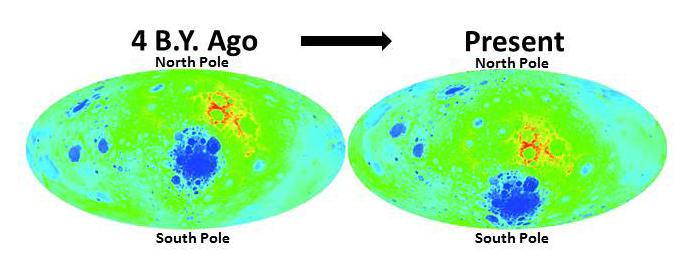Moon's Spin Axis Four Billion Years Ago Was Tilted Several Tens Degrees More Than It Is Today
Published: February 19, 2015
The lunar magnetic field observation team of the Japan's lunar explorer "Kaguya" (SELENE), consisting of Dr. Futoshi Takahashi, Associate Professor in the Graduate School of Sciences at Kyushu University, and Dr. Hideo Tsunakawa, Group Leader and Professor in the Graduate School of Science and Engineering at the Tokyo Institute of Technology, has analyzed satellite observation data and discovered that the Moon had a global magnetic field in ancient times, as the Earth does, and that the Moon's rotation axis was tilted several tens degrees more than it is today.
Although at present the Moon has no global magnetic field (*note) like the Earth does, some lunar rock sample analyses suggest that it could have had a magnetic field around four billion years ago. The present study was the first attempt to estimate the magnetic pole position from the lunar magnetic anomalies in a wide area of the Moon. They used a large number of observation data obtained by the lunar magnetometers of Japan's lunar orbiter "Kaguya" and the US lunar orbiter "Lunar Prospector." The analysis of the magnetic anomalies to estimate the lunar paleomagnetic pole position around four billion years ago found two distinct magnetic clusters: one near the present rotation axis and the other around mid-latitude on the far side of the Moon. The former was positioned near the current geographical pole, but the latter offset from the current geographical pole by several tens degrees. Since the magnetic axis is more or less aligned with the rotation axis, we can assume that the Moon's rotation axis at that time was oriented at a considerably different angle than the present axis of rotation. As one of the two magnetic clusters was positioned offset from the rotation pole by 30 to 45 degrees, the rotation axis of the Moon was tilted several tens degrees more than it is. In other words, about four billion years ago, the Moon showed a different face to the Earth than it does today.
The outcome of this research is expected to lead to the establishment of a new model of the evolution of the Earth-Moon system and make a scientific contribution to the formulation of new lunar exploration plans in the future.
This research was posted on the website of the international British scientific journal Nature Geoscience at 6 pm British Standard Time on Sunday May 4, 2014.

Locations of the north and south poles
Reference
Authors: |
Futoshi Takahashi, Hideo Tsunakawa, Hisayoshi Shimizu, Hidetoshi Shibuya and Masaki Matsushima |
Title of original paper: |
Reorientation of the early lunar pole |
Journal: |
Nature Geoscience 2014 |
DOI: |
|
. Any information published on this site will be valid in relation to Science Tokyo.



